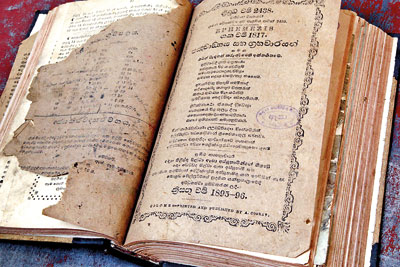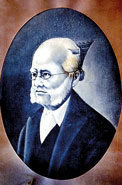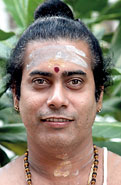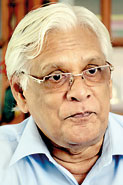There’s a time for everything
View(s):As we celebrate the National New Year today, Shaveen Jeewandara looks at the importance of the almanac in the lives of both the Sinhala and Tamil communities
The erabadu flowers put on their best shade of red, and the kavum dance happily in the frying pan. Astrologers all around the country flip through the pages of the Panchanga Litha, seeking to learn how the planets have positioned themselves this year around. The New Year has dawned, opening up vistas of new possibilities, and even those who would not usually conform to auspicious times keep a watchful eye on their clocks. Do the auspicious times really have a bearing on the way the New Year unfolds?

Turning back the pages of time: The oldest Ephemeris in the possession of Indika Epa Seneviratne. Pix by M.A. Pushpa Kumara
“Auspicious timing deals with astrology and not so much astronomy. Astrology is not a perfect science. It’s partly stemmed from belief, only because you don’t know the exact technicalities,” says Emeritus Professor J. B. Disanayaka.
Whether you partake in auspicious activities only on the day of Avurudu, or all year around the almanac or Ephemeris (Panchanga Litha) is what you would turn to. The honour of printing the almanac has long since been bestowed on the Epa family, which now is in the fifth generation of carrying out this onerous responsibility.
Indika Arosha Epa Seneviratne currently heads the editorial board and we meet him in the diminutive Epa printing press, stuck between the cramped edifices of central Maradana, where he takes us through the history of the publication. The beauty, we learn, lies in the 159 long years of its existence making it one of the oldest continuous publications in Sri Lanka. Indika’s great-great grandfather, Don Philip Epa Appuhamy was the pioneer of the almanac and had ventured out in search of astrological knowledge to India where he mastered the art of astrology under a famous astrologer Atthawaiyangal of Kanchnur.
Returning home, Epa Appuhamy published the Panchanga Almanac and Ephemeris in 1854, in collaboration with a renowned astrologer Ahungalle Gurunnanse. Epa Appuhamy was a visionary, and had an astute business sense. Following a disagreement with the Gurunnanse, Epa Appuhamy took over the entire process of publication, basing it on the vast astrological knowledge he had acquired.
This was a time that he built up trust with the public as well as the Buddhist clergy. Having close association with the Venerable Hikkaduwe Sri Sumangala Thera, he himself prepared the auspicious times to commence the Vidyodaya Pirivena, subsequently becoming the first President of the Vidyodaya Pirivena Executive Committee.

Don Philip Epa Appuhamy: Founder of the Panchanga Almanac
“It was the close relationship with the clergy that paved the way for the Epa’s Almanac into every Sinhala household, establishing itself as the sole source of obtaining accurate times of auspicious moments,” claims Indika. An almanac in its core is a script which contains all auspicious details relevant to the New Year and other days of importance in a year, while an Ephemeris or “Panchanga” deals with the Dinaya, Nekatha, Thithiya, Yoga and Karana, which are the five components essential to calculate auspicious times of a particular date.
He reaches to open a cupboard, and pulls out an ancient book which he lays carefully on the table. Its pages are tattered, the spine coming apart. Dusting off the cover, he tells us that this is the oldest Ephemeris in his possession, dating to 1892.
An interesting fact that we come across is that the auspicious times are the same for the Sinhalese as well as Tamils. We speak to Shanmugaradna Kurukkal, of the Bambalapitiya Kathiresan Kovil who tells us that they too refer the Panchaangam to obtain the times. “We refer to the Panchaangam that is held in high regard, we always get the youngsters involved in carrying out rituals because we want to sustain our culture,” he tell us. The Hindus have a slightly more holistic approach to auspicious times, than the Buddhists and they see it more of an obligation than a choice. However, the rituals practised are more or less the same.
“The calculation of auspicious times is based on the position the Sun takes,” says Professor. Disanayaka, “In this light, the traditional significance of the Sinhala and Tamil New Year is the transition of the Sun from the Pisces (Meena) segment to Aries (Mesha). This heralds the dawn of a new year, while the mistakes and grievances of the old year are swept away.”

Shanmugaradna Kurukkal
Astrologers believe that the period of time where the Sun transits from Pisces to Aries, is void of any auspicious moments because you cannot calculate an exact time – thus leading to an absence of auspicious moments, or Nonagathaya.
Professor Disanayaka tells us that this transition is believed to be ritualistically dangerous, and a sense of ambiguity is instilled in the hearts of all Sinhalese. “The Sun cannot help you in your work anymore. Since ancient times, the only place to salvage a fearful heart has been the temple. The temple is where you go to feel secure, and thus the Nonagathaya is best spent observing religion and attaining merit.”
He mentions that although from a purely astrological viewpoint people go to the temple for security, the greater or more beautiful purpose he believes is the amalgamation of the temple and the people. “Some Buddhists who would never visit the temple would at least on the eve of Avurudu mingle with the temple and the Maha Sanga. This helps to uphold the beautiful concept of the village and the temple being in conjuncture.”
The other rituals during the period of transition are to avoid perusal or contact with anything that would usually bring forth prosperity. “The elements of water and fire are essential to our sustenance, we mostly owe our lives to it. And in a spirit of honour and sacredness the Sinhalese would make it a point not to engage in activities surrounding these elements.
“No one will go to the well, the water that is needed will be collected beforehand. The fireplace will be cleaned and symbolically the soot that we have accumulated over the last year will be absolved in the new fire that brings hope, prosperity and positivity,” he says.
“Milk is also considered an essential element. Milk is what a newborn child would drink and it signifies the heralding of a new era, new relationships and new thinking. Thus we abstain from drinking milk, till it is added to the milk-rice which is cooked from the fireplace that is lit at the first auspicious time for the new year, being the dawn of the new year.”

Prof. J.B. Disanayaka
Another aspect is abstaining from doing any work. Ritualistically it is in our best interests to start work symbolically at the auspicious dawn of the new year.
The Sun’s transition is also observed by the Hindus. “This time ends with a ritualistic puja, that is observed in every Hindu household,” says Shanmugaradna Kurukkal, whereas the Sinhalese would end the Nonagathaya with the lighting of a new fire. “The real beauty of pertaining to an auspicious time is that the whole Sinhala and Tamil community of the island do the rituals together as one,” says Prof. Disanayaka. “That is the real purpose behind it all.”
For Pubudu Dias, 26, a research and development engineer, auspicious times only come into play during the two days of Avurudu. Every other day is taken as it comes. “I am not a believer in depending on planetary positions to determine my success. My education, as well as my profession has taught me that science is the only explanation.” However, Pubudu makes it a point to carry out all the rituals pertaining to the auspicious times on Avurudu day, in the best interests of preserving a Sinhala identity. “It is an obligation to make sure that we carry forward an identity, where everyone in the community would light the hearth,” he says.
For Tharaha Ganeshadasan, 20, auspicious times do matter. “We have a calendar that is given to us from the temple called the ‘Panchaangama’ and we follow the timing that is stated before doing any event of importance.” For Tharaha, it’s a practice that has come down from her parents, both strict Hindus. They are firm believers in sticking to the auspicious time in order to ensure success in their tasks, and have instilled this in their children. “Personally, I feel content when I follow the timing, in the case of an exam or filling out a university application. I know it’s based entirely on astrology of which we have no thorough understanding, but it keeps me happy and positive, and I suppose that’s what counts.”
The Ganeshadasans are Jaffna-Tamils, and the New Year is best spent back in Jaffna. “Since I am living in Colombo, the extent to which we carry out the rituals are limited. If we were in Jaffna, sure, we would fulfil all the rituals to the dot. There are a lot of games and celebrations among the family.”
“The New Year is the time when relatives who are spread far and wide come together to celebrate the family. It is a time to mend broken relationships and build new ones,” says Professor Disanayaka. “The word ‘aluth’ in the Avurudda signifies just that.” The New Year, he tells us, is an opportunity to start talking with a relative you have quarrelled with, and embracing your family and religion. “I would least care if the New Year dawned at 11.58 p.m. or 11.59 p.m. What matters is not the auspicious timing, but the purpose behind it. I get the chance to see the faces of my grandchildren and that’s what is important to me.”
Similarly, everyone has their special reasons to celebrate the Sinhala and Tamil New Year and whether you wait for that auspicious time or not believing in the true sense of togetherness will bring the true joy of the New Year.
Auspicious times
Nonagathaya:7.05 p.m, Saturday, April 13 till the dawn of the New Year.
Dawn of the New Year: 1.29 a.m., Sunday, April 14.
Lighting the fire (Lipa Gini Melaveema) and preparing meals: 4.06 a.m., Sunday, April 14. The auspicious direction is South, and auspicious colour of clothes is blue.
Eating the first morsels (Ahara Anubhawaya) and entering into the first business transaction (Weda Alleema, Ganudenu):7.05 a.m, Sunday, April 14. Auspicious colour to be worn is bronze (red and yellow mix).
Anointing oil (Hisa thel gema): 6.41 a.m, Monday, April 15, facing the Eastern direction. Auspicious colour to be worn is white.
Leaving for duty: 7.42 a.m, Wednesday, April 17, after eating kiribath prepared with jaggery wearing green coloured clothing. Auspicious direction to set off in is towards the South.
Follow @timesonlinelk
comments powered by Disqus















